
 |
|
|
#1 |
|
Lex Parsimoniae
Join Date: Feb 2009
Location: Woburn, MA
Posts: 4,918
Thanks: 114
Thanked 250 Times in 230 Posts
|
I checked the AC outlets this morning and got 125VAC..
I think this means that I'm putting 250 volts on my Sanyo Mini-split.. Looking at the label, it seems like Sanyo wants 208 to 230 vac.. 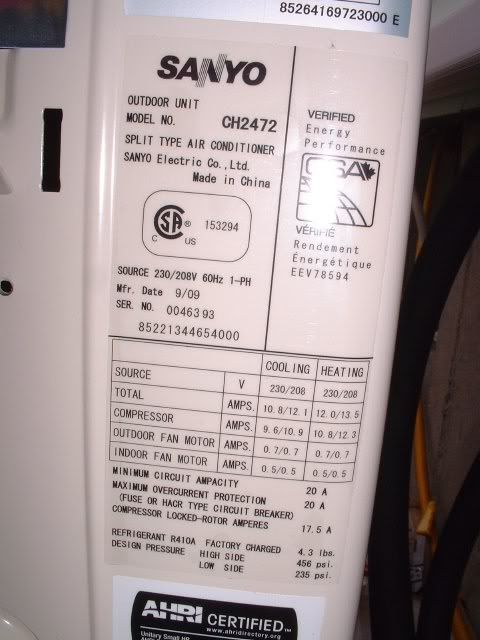 The manual says "187 to 253 Available Voltage Range" So, 250 very close to the top end of the range.. Since this is an inverter unit, and it most likely runs the AC right into diodes, to make DC for the DC motor..?. Maybe 250vac is making my Sanyo draw a bit too much current.. And use too many watts?? Is 250vac in the normal range, or do I need to call the power company? What's in your outlets?? Wait a sec! It's Turkey day and everyone on my street us using electric ovens! So the line voltage should be lower..?. Or did the power company over-compensate? I'm wondering if my 220 was like 259 at 7:30 this morning?? Thanks, Rich |
|
|

|
|
|
#2 |
|
Journeyman EcoRenovator
Join Date: May 2009
Location: Buffalo, NY
Posts: 344
Thanks: 3
Thanked 17 Times in 15 Posts
|
Since you've got more voltage, it will take less current to produce the same output, and the unit will run at lower duty cycle. It probably won't use more power.
I'm at 121.5V open circuit, which is only a hair higher than typical. |
|
|

|
|
|
#3 | |
|
Lex Parsimoniae
Join Date: Feb 2009
Location: Woburn, MA
Posts: 4,918
Thanks: 114
Thanked 250 Times in 230 Posts
|
Quote:
Since there isn't much inductive reactance at the input, I think this is more of an Ohms law thing. Power= Volts x Amps. So, if the volts go up, so does the watts. It's working normally now.. Idling at 460 watts. But this morning, it was at 600w when I called for more heat (20C to 21C) it oozed on up over 2kw in about a minute.. Some testing showed readings of about 2.6 KW before I stepped it back down. It was about 25f outdoors.. |
|
|
|

|
|
|
#4 |
|
Lex Parsimoniae
Join Date: Feb 2009
Location: Woburn, MA
Posts: 4,918
Thanks: 114
Thanked 250 Times in 230 Posts
|
I've looked around on the web and could not find any schematics of the power supply
of a mini-split inverter type AC/heatpump. Just block diagrams like mine..  So, I'm going to make some guesses about where the compressor & fan get their juice. (It's logical there would be also be a small transformer type supply for the logic board). The incoming AC (250vac) is filtered, passes through a relay, and then goes directly into diodes, where it's converted into DC voltage. On the rectifier output, there are capacitors, to remove 60hz ripple. This filtered raw voltage DC is likely so high, it's not regulated in any way. It's switched into the motors by high powered MOSFETs. It's my theory that an overly high AC input voltage exposes the components to abnormally high DC voltage. The higher voltage on the motors would make them draw more current. Increasing the power used by the unit, to abnormal levels. |
|
|

|
|
|
#5 |
|
Journeyman EcoRenovator
Join Date: May 2009
Location: Buffalo, NY
Posts: 344
Thanks: 3
Thanked 17 Times in 15 Posts
|
I mean, it won't use more energy during the course of a day. It will draw more power and heat your house faster than it would at a lower voltage. However, the controller will respond by running it at a lower duty cycle, or by spending less time at higher power states. Input voltage won't really affect the efficiency of the unit.
|
|
|

|
|
|
#6 |
|
Lex Parsimoniae
Join Date: Feb 2009
Location: Woburn, MA
Posts: 4,918
Thanks: 114
Thanked 250 Times in 230 Posts
|
I don't think the controller program is smart enough to know that it's seeing higher than normal voltage.
I think there are two controllers. The master in is the indoor unit and sends commands down to the outdoor unit via a serial cable. The outdoor unit is likely Dumb, compared to the indoor unit. And, the outdoor unit might have that Ramp-up routine.. After a call for more heat, I think it starts a slow ramp up towards a certain peak value. But it increments the speed upwards pretty quickly. Within a minute or two, (Typically, the temperature in the room will not change that fast) it will hit a peak power usage (normally between 900 & 1800 watts) and then start stepping downwards, at about the same pace. (Regardless of room temp). When it gets down to low power (about 480 watts), it stays there.. Wandering up and down slowly, until the room heats up and it shuts down. The Peak is a pre-programmed "Must Do" item during turn-on or stepping up the temp. While it's stepping, I think the software isn't looking at any feedback, like RPMs.. Any feed back sensor on the compressor motor is likely just used for basic motor control. Like timing the drive pulses. I think the firmware just picks it's power levels out of a table, one step at a time. And, it's probably a table based on a voltage between 187 to 253 volts. The number 220 falls exactly between those two numbers.. Once it's coasting for a while, it looks at the room temp and decides to turn up or down the juice if needed. My old theory was: 36,000 BTU firmware in my 24,000 BTU indoor unit.. I know the unit is drawing 12A at 250vac (3kw) when it goes off the deep end. It could be a combination of dumb firmware and high AC voltage..?. |
|
|

|
|
|
#7 |
|
Master EcoRenovator
Join Date: Dec 2008
Location: Vancouver Island BC
Posts: 745
Thanks: 23
Thanked 37 Times in 30 Posts
|
25f is roughly -4C does the heat pump actually work at that temperature or does it kick on some form of back up? At -6 my thermostat kicks on the back up heater if I ask for 1/2 degree warmer. I'm not sure if thats a limit for heat pumps or if the thermostat is just pessimistic about the time involved in getting the heat. My meter really spins when the 30kw electric furnace fires up.
|
|
|

|
|
|
#8 |
|
Lex Parsimoniae
Join Date: Feb 2009
Location: Woburn, MA
Posts: 4,918
Thanks: 114
Thanked 250 Times in 230 Posts
|
It works fine down at 25f. It uses more power as it gets colder, but it still works pretty well, down to 10 degrees F.
It uses more power when it's real cold and I turn on the oil-heat once it gets down under 8 degrees. (Rarely). But there is no built-in back-up heating element. There is a small "crank-case" element that runs when the system is in idle mode, or even turned off.. The meter always shows 40 to 60 watts, unless it's really hot outdoors. In the summer, I turn off the main breaker to save that 50w.. The setting overnight was 20c. This morning, it was using 460w as I clicked it up to 21c, and watched the power meter change about every 12 to 24 seconds. (It updates every 6 seconds). 460,850,870,1.28,1.39,1.43,1.60,1.67,1.74,1.60,1.32,1.28,1.11,1.09,860, 830,800 and so on.. I came back about 5 minutes later to see it was staying at 570 to 610 watts. It will stay there until the thermostat shows 22c for a few minutes and then it will drop back to the 460w mode. Turning off (60w) if the sun comes out making the thermostat shows 23c or more. The unit seems to want to jump up to a peak about 1300 watts higher than what it's currently using. So 450 + 1300 = 1750watts and that's fine.. But, if the system is using 750w? (like right now).. I just clicked up to 22c and within about 48 seconds, it ramped up to 2,000-plus watts. I set it back to 21, to stop it from ramping up any higher. Because, it can ramp up to 2,600-plus and the Over-load or high-pressure(?) switch will pop and open the power input line. After the old unit did a few of these 'Resets', it blew a 410A line and lost all pressure.. Current AC line voltage is 248vac. I kinda wish it was under 230..  So, if I want it to be 22c in here, I've got watch the power meter.. When it gets down to 400-500w, then I can call for more heat.. And, I can never call for a 2 degree C change.. It goes into to Turbo mode!  It stinks having to baby this system, but we don't want it to break again!! We do not want to heat with oil again.. I'm waiting for a reply from NSTAR. See if they think 250vac on my 220 line is okay.. |
|
|

|
|
|
#9 |
|
Lex Parsimoniae
Join Date: Feb 2009
Location: Woburn, MA
Posts: 4,918
Thanks: 114
Thanked 250 Times in 230 Posts
|
It's 25F outdoors this morning and we are having the same problem that we had last Dec.
http://ecorenovator.org/forum/geothe....html#post5159 After all night set at 20C (68F), the Sanyo was using above 600w. Normally, it would be about 440-480w. At above 500w, a request for 1deg C increase, causes excessive power usage. (>2,300w) Normally, When the idle (maintaining heat power usage) is under 500w, A request for more heat brings the usage up to <2,000 watts. There are two things that might be causing this problem. 1. The R410a might be leaking out.. 2. The 250vac line voltage might be too much for the Sanyo. When it gets warmer outdoors, I might have to pull off the cover set and perform another inspection of the compressor compartment. If it's leaking, there should be some lubricant showing up. Because this (high power usage) has suddenly gotten worse this week, I suspect that something has changed.. Last edited by Xringer; 11-28-10 at 08:44 AM.. Reason: typo.. |
|
|

|
|
|
#10 |
|
Lex Parsimoniae
Join Date: Feb 2009
Location: Woburn, MA
Posts: 4,918
Thanks: 114
Thanked 250 Times in 230 Posts
|
The voltage was 125.5 on the outlets this morning.. 251 volts going to the Sanyo!
Could not increase the temp by 1C this morning, since the idle use was 500-600watts. We tried it a few times, with power readings going up to 2.7 kw (no breaker pop). and after a few tries, got it running stable again at 21C @ 500-600watts. I hope to hear from NStar today.. 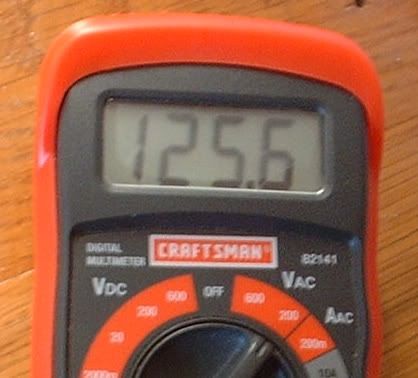 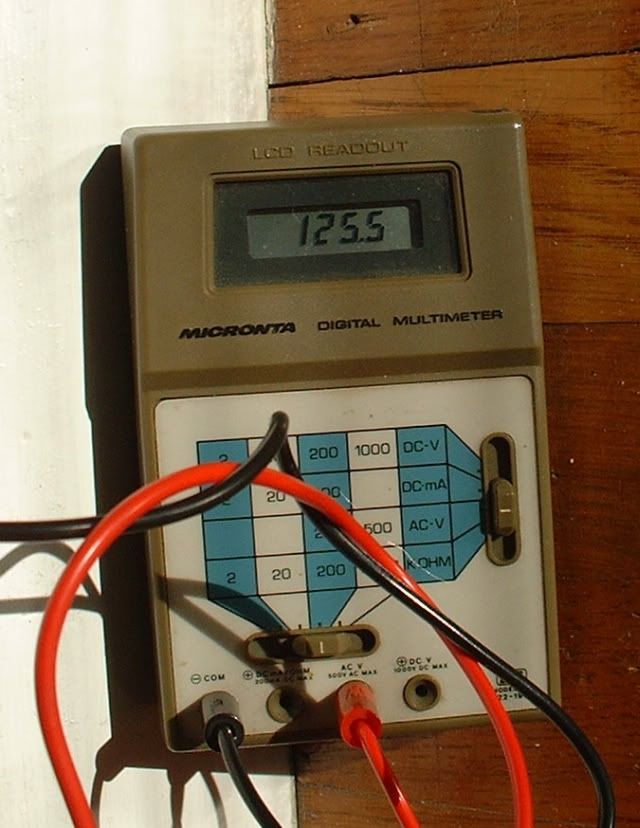 I've got 4 VOMs and they all show about the same readings. 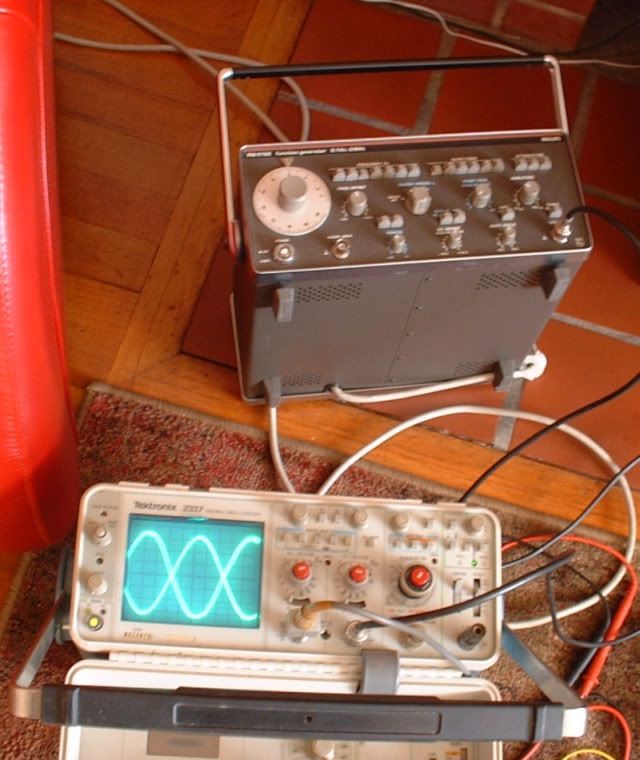 After seeing the noise and flat topping on the AC line with the O-scope, I connected up a sig-gen to see if there was any problem with the scope. Noise spikes just after the peak, and smaller busts of noise about half way on the slopes. 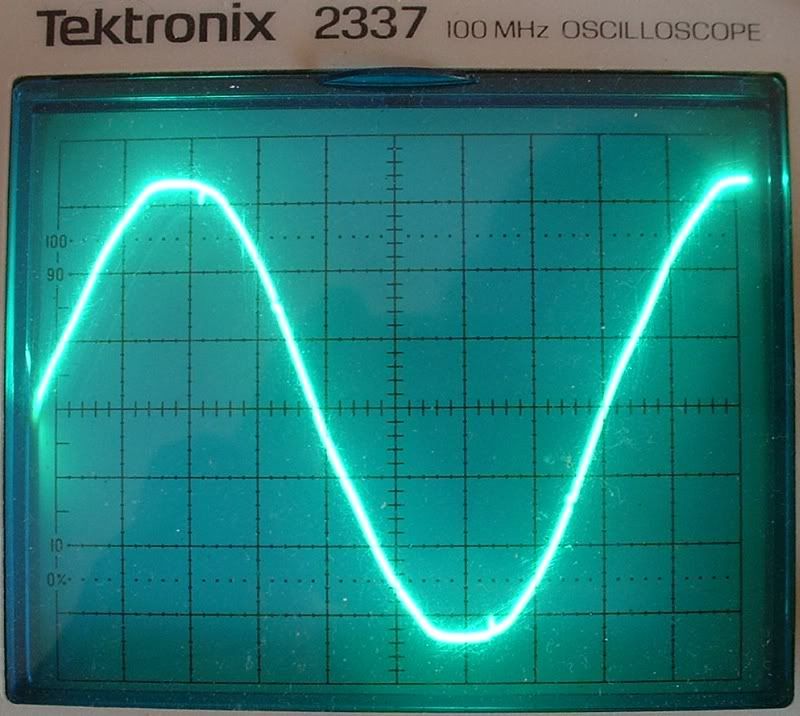 There was no problem with the scope, as you can see from the clean sig-gen peak on right. 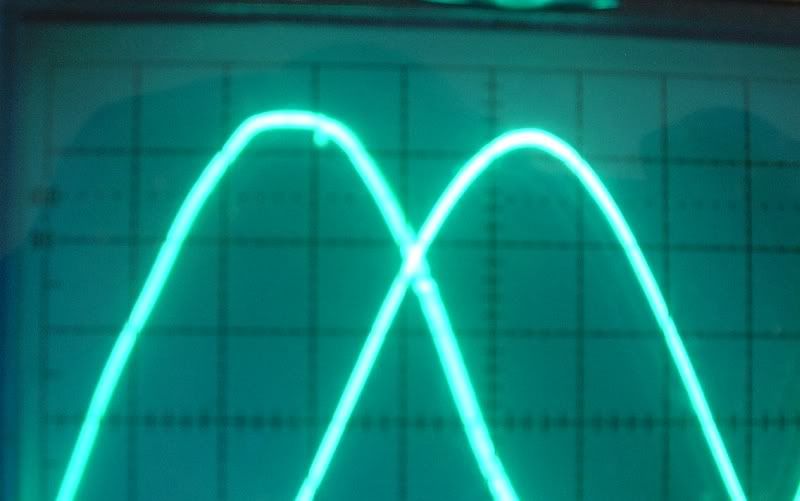 Last edited by Xringer; 11-29-10 at 08:40 AM.. |
|
|

|
 |
| Thread Tools | |
| Display Modes | |
|
|